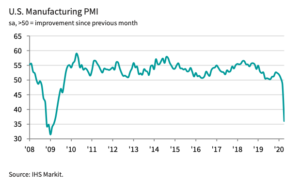COVID-19, the pandemic of the 21st Century, has brought the global supply-chain to a grinding halt for all manufacturing industries except paper products and food, beverage, and tobacco, according to ISM Report on Business, April 2020. The pandemic hit us like a freight train.
The U.S. Manufacturing PMI (Purchasing Manager’s Index) graph (below) shows the direction of the economic trends in manufacturing. The crisis sends the PMI into a vertical dive as we have never seen before. This is the result of countries having to take drastic measures to shut down their economy and require their citizens to shelter in place for months to prevent the spread. Every business along the supply chain is shutting its doors abruptly overnight.

Before the pandemic, the electronics industry had already been suffering from the shortage of components due to the explosion in technological innovations and the surge in government defense spending. Artificial intelligence, 5G, Blockchain, self-driving, and electric cars create demand for new products. To replace the outdated carrier’s fleet, the United States Department of Defense has ordered 10 new classes of super carriers, with the first carrier to be delivered and commissioned into service later this year. If you’re working in the supply chain/procurement department, you have your ‘work cut out’ for you.
As the demand exceeds the supply at the distributors, and lead times are getting longer at the component manufacturers, it creates a “toilet paper gate,” where big companies like Apple and Google are hoarding the materials. If you are a buyer working at a startup or small company, your 14-hour workday is now a norm. The materials procurement team is desperate to get the materials so they can build and ship products to their customers. They have to look into a different option to get the materials: buying from a broker in the gray market.
Risks of buying from brokers
Buying materials from brokers is like playing a game of Russian Roulette. Every time you purchase materials from a broker, you are spinning the pistol cylinder in the hope that you don’t receive counterfeit components. Most brokers themselves don’t know where the components are coming from. There is no visibility and transparency in the gray market. It’s the wild wild west. This is why in recent years counterfeit components have become a major issue. Besides the counterfeit risk, dealing with unknown brokers, especially from overseas, poses another issue – trust. There is simply no brokers rating system or way to know who you are dealing with. It could be some kids in Africa sending out a scam email posing as a vendor. The brokers demand payment in full before shipping out the materials. Because of these fears, buyers choose to work with a few well-known brokers. Even this way, counterfeit materials have found their way to the buyers.
Materials shortages, long lead times, and now demand order/production disruptions due to the COVID-19 shutdown create the perfect storm for the industry. When the pandemic crisis is over, the materials/inventory nightmare begins. Here is the irony: While you are frantically locating components to fill your shortages to meet the outgoing shipments, you also face an excess of other types of components due to minimum order quantity (MOQ) and canceling orders. These issues are not new, but the pandemic crisis magnified it 10 fold. But there is a “light at the end of the tunnel.”
One solution: sharing communities
Literally, “it takes a village” (African proverb) to solve these issues – a sharing-community for the electronics components – MOQller.com. An ecosystem that allows companies to connect and share only the materials information; the companies’ identities remain anonymous during the trading process. An easy-to-use, secured, and trusted community will prevent counterfeit materials, save you time and money, and help reduce excess-inventory for your company. Now you can locate materials to fill your shortages through others’ excess-inventory. Here are 10 more advantages of using MOQller.com over a broker:
-
- We only release your payment to the sellers after you confirm receipt of shipments.
- Your materials purchases will be shipped from the seller’s warehouse to MOQller. We then repackage and ship to you.
- Your company information will not be visible to the sellers and vice versa.
- You buy the materials with a shorter lead time and in smaller quantities.
- If you cannot locate the materials on MOQller Marketplace, send us your (wish) list to info@moqller.com. Our team will locate the materials for you. We have access to companies’ approved vendor lists, so we know who is using the same components as you.
- There is only a 15% fee per transaction.
- Sellers are encouraged to list their excess as soon as possible, so for the material you buy from them the date codes are newer and not old due to sitting in the warehouse for years.
- Net 30 payment option (end of 2020).
- You can freely buy materials at MOQ from the distributors and then list your unneeded portion of those materials on MOQller.com for sale right away.
- It’s free to join the MOQller community.
- You not only save time and money but also do good for the environment (reducing e-waste).
We built this community for you. “Every year we create 50 million tons of e-waste per year. This is equivalent in weight to 4,500 Eiffel Towers” (World Economic Forum). Join the MOQller Sharing-Community and help create a better world. Let’s be a part of the solution.

